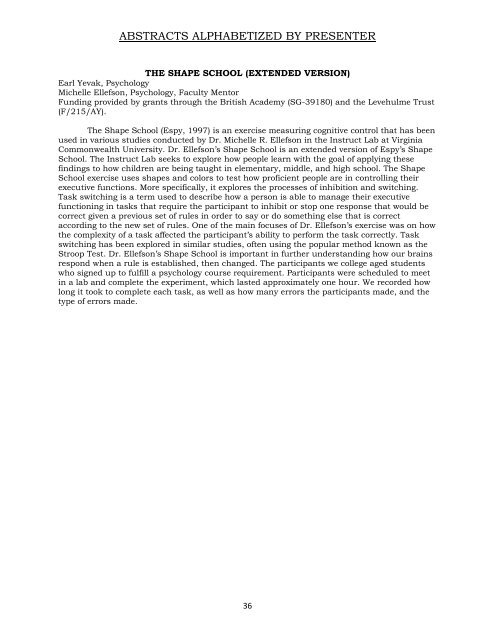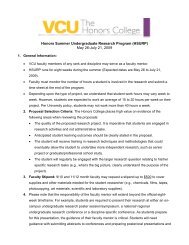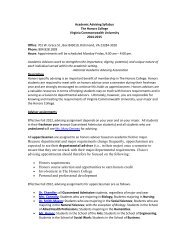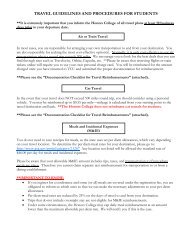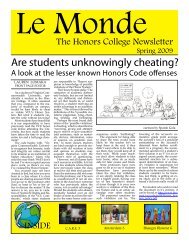here - VCU Honors College - Virginia Commonwealth University
here - VCU Honors College - Virginia Commonwealth University
here - VCU Honors College - Virginia Commonwealth University
Create successful ePaper yourself
Turn your PDF publications into a flip-book with our unique Google optimized e-Paper software.
ABSTRACTS ALPHABETIZED BY PRESENTER<br />
THE SHAPE SCHOOL (EXTENDED VERSION)<br />
Earl Yevak, Psychology<br />
Michelle Ellefson, Psychology, Faculty Mentor<br />
Funding provided by grants through the British Academy (SG-39180) and the Levehulme Trust<br />
(F/215/AY).<br />
The Shape School (Espy, 1997) is an exercise measuring cognitive control that has been<br />
used in various studies conducted by Dr. Michelle R. Ellefson in the Instruct Lab at <strong>Virginia</strong><br />
<strong>Commonwealth</strong> <strong>University</strong>. Dr. Ellefson’s Shape School is an extended version of Espy’s Shape<br />
School. The Instruct Lab seeks to explore how people learn with the goal of applying these<br />
findings to how children are being taught in elementary, middle, and high school. The Shape<br />
School exercise uses shapes and colors to test how proficient people are in controlling their<br />
executive functions. More specifically, it explores the processes of inhibition and switching.<br />
Task switching is a term used to describe how a person is able to manage their executive<br />
functioning in tasks that require the participant to inhibit or stop one response that would be<br />
correct given a previous set of rules in order to say or do something else that is correct<br />
according to the new set of rules. One of the main focuses of Dr. Ellefson’s exercise was on how<br />
the complexity of a task affected the participant’s ability to perform the task correctly. Task<br />
switching has been explored in similar studies, often using the popular method known as the<br />
Stroop Test. Dr. Ellefson’s Shape School is important in further understanding how our brains<br />
respond when a rule is established, then changed. The participants we college aged students<br />
who signed up to fulfill a psychology course requirement. Participants were scheduled to meet<br />
in a lab and complete the experiment, which lasted approximately one hour. We recorded how<br />
long it took to complete each task, as well as how many errors the participants made, and the<br />
type of errors made.<br />
36


